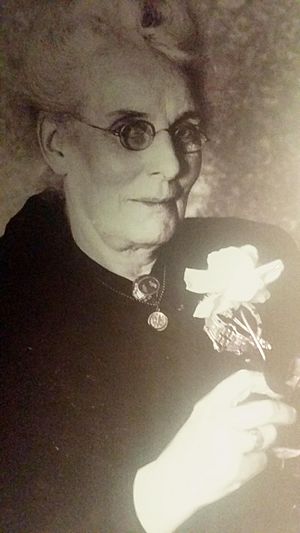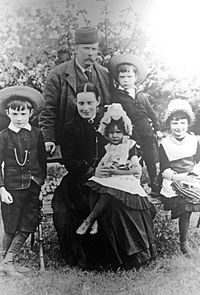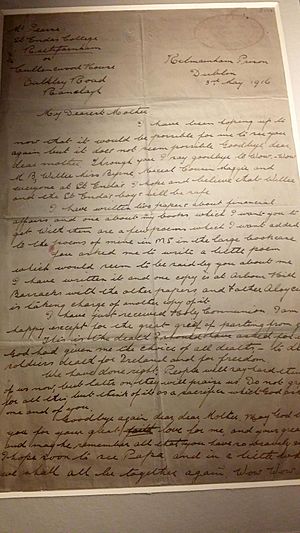Margaret Pearse facts for kids
Quick facts for kids
Margaret Pearse
|
|
|---|---|
 |
|
| Teachta Dála | |
| In office May 1921 – June 1922 |
|
| Constituency | Dublin County |
| Personal details | |
| Born |
Margaret Brady
12 February 1857 Dublin, Ireland |
| Died | 22 April 1932 (aged 75) Dublin, Ireland |
| Political party | Fianna Fáil |
| Other political affiliations |
Sinn Féin (until 1926) |
| Spouse | James Pearse |
| Children | 4, including
|
| Occupation |
|
| Known for | Mother of Patrick Pearse |
Margaret Pearse (born Margaret Brady; 12 February 1857 – 22 April 1932) was an important Irish politician. She was the mother of Patrick Pearse and Willie Pearse. Both of her sons were executed after the 1916 Easter Rising, a major rebellion in Ireland. Margaret Pearse later became a member of Dáil Éireann, which is the main parliament of Ireland.
Contents
Margaret Pearse's Early Life
Margaret Brady was born in Dublin, Ireland, on 12 February 1857. Her father, Patrick Brady, was a coal merchant, and her mother was Brigid Brady. Margaret was one of four children in her family. She went to school with the Sisters of St Vincent de Paul. Later, she worked in a stationery shop. This is where she met her future husband, James Pearse.
Family Life and Children
In 1877, Margaret married James Pearse. This was James's second marriage. He was a sculptor who had moved to Ireland in the late 1850s.
Margaret and James had four children together. Their first three children were Margaret Mary, born in 1878, Patrick, born in 1879, and William, born in 1881. Their youngest child, Mary Brigid, was born in 1888.
Margaret's aunt, also named Margaret Brady, often visited the family. She was an Irish speaker and helped the children learn about the Irish language and Irish culture. James Pearse, Margaret's husband, passed away in 1900. Margaret was very supportive of her children's dreams. She also became the housekeeper at St. Enda's School, a school founded by her eldest son, Patrick.
Margaret Pearse's Political Journey
Margaret strongly supported her sons' political beliefs. After they were executed in 1916, she wanted to keep their memory and ideas alive. This led her to become involved in politics herself.
She joined the political party Sinn Féin after the Easter Rising. She helped support candidates during the 1918 elections. In 1920, Margaret ran as a Sinn Féin candidate in the local elections for the Rathmines area of Dublin and was elected.
In the 1921 elections, she was elected to Dáil Éireann. She became a Teachta Dála (TD), which is a member of the Irish parliament, representing the Dublin County area.
Opposing the Anglo-Irish Treaty
Margaret Pearse was strongly against the Anglo-Irish Treaty. This treaty was an agreement that created the Irish Free State. All the women TDs in the Dáil also opposed it. During the debate about the Treaty, Margaret spoke powerfully. She said that her son, Patrick Pearse, would never have accepted it. She felt that accepting the Treaty would betray her sons' sacrifice.
She famously said:
I feel in my heart – and I would not say it only I feel it – that the ghosts of my sons would haunt me."
After the Treaty was approved, Margaret and other TDs who opposed it left the Dáil. She lost her seat in the 1922 general election. She continued to support those who fought against the Treaty during the Irish Civil War. She remained a member of Sinn Féin until 1926.
Joining Fianna Fáil
In 1926, Margaret left Sinn Féin with Éamon de Valera. She then became one of the founding members of a new political party called Fianna Fáil. She did not run for election again after this. Her daughter, Margaret Mary Pearse, also joined Fianna Fáil. She later became a TD and a Senator.
Later Years and Lasting Impact
Margaret Pearse played an important role in public life. When The Irish Press newspaper was launched, she was asked to press the button to start the printing presses. She often said that if her sons were alive, they would have joined Fianna Fáil. Because of this, Patrick Pearse is still seen as a guiding figure for the party today.
Patrick Pearse had founded St. Enda's School in 1908. After his death, Margaret Pearse and her two daughters, Mary Margaret and Mary Brigid, took over running the school. The school faced financial difficulties. In 1924, when Margaret was 70 years old, she traveled to America to raise money for the school. She also used this trip to show support for Éamon de Valera and the idea of an independent Irish Republic.
During her trip, Margaret proudly spoke about her sons. She raised over $10,000 in donations for St. Enda's School. However, despite her efforts, the school eventually closed in 1935.
A street in Dublin, Great Brunswick Street, where the Pearse family once lived, was renamed Pearse Street in 1920 to honor the family.
Margaret Pearse's Death
Margaret Pearse passed away in 1932. She received a large state funeral, which showed how important she was to Ireland. Many people came to pay their respects as her funeral procession went through the streets of Dublin. The procession even paused for a moment of silence at the General Post Office. This was where Patrick and William Pearse had fought during the Easter Rising.
She was buried in Glasnevin Cemetery. Éamon de Valera gave a speech at her funeral, praising her courage and kindness. After Margaret's death, her daughter, Mary Margaret, continued to live at St. Enda's. When Mary Margaret died in 1968, she followed her mother's wish and gave the house to the people of Ireland.



